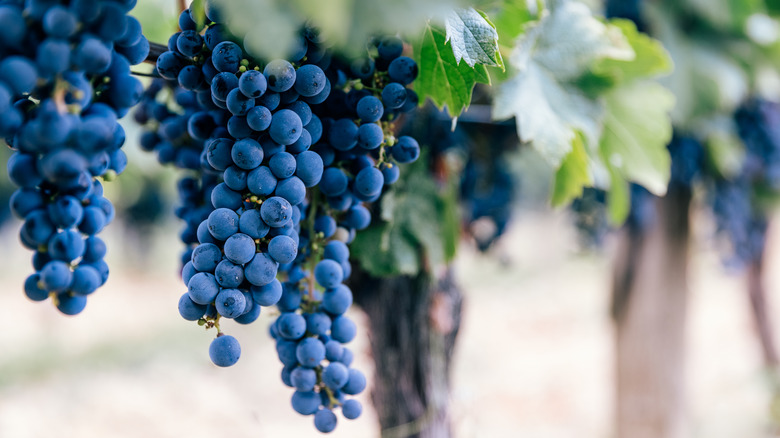The Differences Between Regular And Natural Wine, Explained
Wine shopping can be challenging if you're not a seasoned drinker; there are tons of different grape varietals, regions, and tasting notes that set each bottle apart. What's more, you're likely to come across bottles with labels like "natural" or "vegan." The trouble is that knowing what makes regular wine different from these natural bottles can be difficult to understand. If you want to get into drinking sustainable wine, however, knowing what makes these bottles special is key.
Doreen Winkler, founder of Orange Glou – the only wine store and subscription service in the U.S. dedicated to orange wines – spoke with Daily Meal to shed some light on these differences. "Natural wine is the product of chemical-free growing, manual harvesting, minimal-intervention vinification, and additive-free bottling," she explains, which means that the wines are handled differently — long before they even make it into a bottle. During the processing, she says, you won't find any unwanted additives, either: "Natural wines are made with only one ingredient — grapes." Plus, she expounds that once you open the bottle, you'll pick up on differences in the drink's flavor, too.
What makes the process for natural wine so different
The differences between natural and regular wine start in the way that the grapes are grown. "This matters because the natural process is what brings us the truest expression of the grape, the soil, and the vintage," Doreen Winkler says. With natural wines, the grapes aren't treated with fertilizers or pesticides during the growing process. That means they wind up being organic wines, although the reverse isn't necessarily true. What's more, the grapes for natural wines are harvested manually, making it less likely for low-quality grapes to make it into your bottle.
Additionally, there are differences in what goes into the wine during production. Winkler explains that, with natural wine, "indigenous yeast is used for fermentation, wine is typically unfined or filtered, and zero to very little sulfites are added." On the other hand, she adds, "In more traditional 'conventional' winemaking, any number of chemicals, manipulations, and additives may be a part of the process." In fact, there are more than 70 different additives that winemakers can legally add to their blends. While most of these additives aren't likely to have any negative consequences on your health, they can cause changes in the wine's color, clarity, and flavor, ultimately affecting your drinking experience.
Flavor differences between regular wine and natural wine
All the differences in processing and harvesting can have some serious impacts on how your wine tastes. Doreen Winkler comments, "Natural wines are easier to drink." They have a balance of flavors, which means you won't find them overly sweet or astringent, and the blend can suit a wide range of palates.
At the same time, Winkler explains, "They tend to have a lower alcohol content than so-called 'regular' wines and just taste more pure — nothing is added that interferes with the flavor of the grape and terroir." In other words, you can better pick up on subtle tasting notes in the drink. At the same time, this can lead to a lighter feel, perfect for sipping on during warmer summer months.
Finally, it's not all about taste. The wine may look cloudy due to the wild yeast used to make it. While it might look unappetizing, don't panic; think of it as something akin to the cloudiness of a good kombucha. All these differences are what make your drink truly unique when you crack open a bottle of natural wine.


